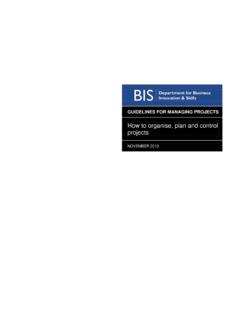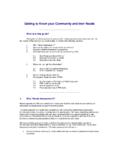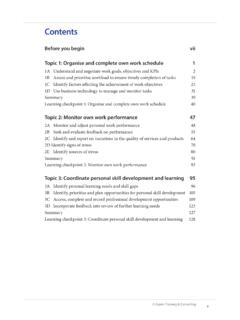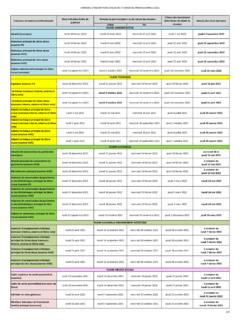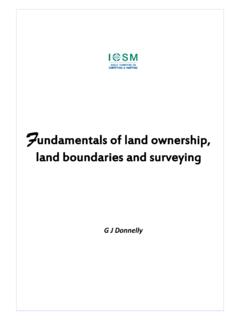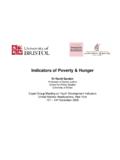Transcription of Code of practice for the welfare of pigs - GOV.UK
1 Code of practice for the welfare ofPIGS National Pig Association Crown copyright 2020 You may re-use this information (excluding logos) free of charge in any format or medium, under the terms of the Open Government Licence To view this licence visit or email This publication is available at ..1 Introduction ..5 Definitions ..6 Section 1 - Recommendations applying to all pigs ..7 Stockmanship and staffing ..7 Health and welfare plan ..7 Disease control and biosecurity ..8 Contingency planning for disease and other emergencies ..9 Inspection ..10 Handling ..11 Tethering ..12 Loading, unloading and transport.
2 13 Marking ..15 Monitoring animal health and welfare ..16 Animal-based measures ..16 Fighting and aggressive behaviours ..16 Body condition assessment ..17 Lameness and limb lesions ..17 Managing sick and injured animals ..18On-farm killing ..18 Responsible medicines usage and record keeping ..19 Accommodation ..20 General ..21 Floors ..22 Enrichment ..23 Ventilation and temperature ..25 Lighting and noise levels ..26 Automated and mechanical equipment ..27 Feed, water and other substances ..27 Management ..30 General ..30 Natural service, artificial insemination and vasectomy .31 Mutilations.
3 32 Tail docking ..32 Managing and reducing the risk of tail biting ..34 Resource factors ..34 Environmental outcome measures: ..35 Animal-based outcome measures: ..36 Identifying, monitoring and managing tail biting incidents ..36 Teeth clipping/grinding ..37 Castration ..38 Section 2 Additional specific recommendations ..39 Farrowing sows and piglets ..39 Weaners and rearing pigs ..41 Dry sows and gilts ..42 Boars ..43 Pigs kept in outdoor husbandry ..45 Accommodation ..45 Feed and water ..46 Fences ..46 Nose ringing ..46 Annex 1: Legislation ..47 Annex 2: Permitted procedures ..49 Sources of further information.
4 51 Code of practice for the welfare of Pigs1 Preface This preface is not part of the Code; instead, it explains the Code s role and the broad considerations on which it is based. This Code applies to England only. It replaces the Code of Recommendations for the welfare of Livestock: Pigs, issued in 2003. The legal text in boxes throughout this document is not part of this Code but highlights relevant legislation. The text in these boxes is the law as it stands on the date that this Code is published (please see the final page for the date of publication). Owners/keepers should be aware that any of the legal requirements quoted here could change, and they should check that they are an accurate statement of the law as it currently stands.
5 See Annex 1 for a list of other relevant legislation. This Code is made under the Animal welfare Act 2006. The Act makes owners and keepers responsible for ensuring that the welfare needs of their animals are met. This includes their need to exhibit normal behaviour patterns; their need to be housed with, or apart from, other animals; their need for a suitable environment; an appropriate diet and to be protected from pain, injury, suffering and disease. Section 14 of the Animal welfare Act 2006 states:14 (1) The appropriate national authority may issue, and may from time to time revise, codes of practice for the purpose of providing practical guidance in respect of any provision made by or under this Act.
6 (2) The authority responsible for issuing a code of practice under subsection (1) shall publish the code, and any revision of it, in such manner as it considers appropriate.(3) A person s failure to comply with a provision of a code of practice issued under this section shall not of itself render him liable to proceedings of any kind.(4) In any proceedings against a person for an offence under this Act or an offence under regulations under section 12 or 13 (a) failure to comply with a relevant provision of a code of practice issued under this section may be relied upon as tending to establish liability, and(b) compliance with a relevant provision of such a code of practice may be relied upon as tending to negative principal legislation referred to in this Code are the welfare of Farmed Animals (England) Regulations 2007 and the Mutilations (Permitted Procedures) (England) Regulations 2007.
7 There may be other legislation and requirements (for example organic standards and legislation for farmed wild boar) that are not outlined in this Code but with which, where relevant, owners/keepers must be familiar and in compliance. See Annex 1 and 3 of the Animal welfare Act 2006 states:3 (1) In this Act, references to a person responsible for an animal are to a person responsible for an animal whether on a permanent or temporary basis.(2) In this Act, references to being responsible for an animal include being in charge of it.(3) For the purposes of this Act, a person who owns an animal shall always be regarded as being a person who is responsible for it.
8 (4) For the purposes of this Act, a person Code of practice for the welfare of Pigs2shall be treated as responsible for any animal for which a person under the age of 16 years of whom he has actual care and control is 6 of the welfare of Farmed Animals (England) Regulations 2007 states:6 (1) A person responsible for a farmed animal (a) must not attend to the animal unless he is acquainted with any relevant code of practice and has access to the code while attending to the animal; and(b) must take all reasonable steps to ensure that a person employed or engaged by him does not attend to the animal unless that other person (i) is acquainted with any relevant code of practice ;(ii) has access to the code while attending to the animal; and(iii) has received instruction and guidance on the code.
9 (2) In this section, a relevant code of practice means a code of practice issued under section 14 of the Animal welfare Act 2006 or a statutory welfare code issued under section 3 of the Agriculture (Miscellaneous Provisions) Act 1968 relating to the particular species of farmed animal to which a person is Code is intended to help all those who care for pigs to practise good standards of stockmanship to safeguard pig welfare . Without good stockmanship, animal welfare can never be adequately protected. Adherence to these recommendations will help keepers to maintain the standards required to comply with relevant legislation.
10 Owners/keepers who care for pigs should demonstrate: Caring and responsible planning and management; Skilled, knowledgeable and conscientious stockmanship; Knowledge of appropriate environmental design; Considerate loading, unloading and transport; and Ability to undertake humane killing. The welfare of pigs is considered within a framework that was developed by the Farm Animal welfare Council (now known as the Farm Animal welfare Committee or FAWC ) and known as the Five Freedoms . These form the guiding principles for the assessment of welfare within any system, together with the actions necessary to safeguard welfare within the constraints of an efficient livestock industry.










